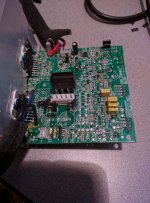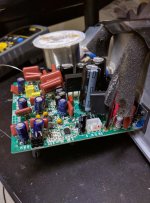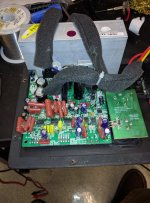Hey folks,
Last fall I overhauled the amps in my Rokit 5 G3s, which completely transformed their character from dull and logy to noticeably clear(er) and dimensional. Felt like someone took some wet cotton swabs out of my ears. They're obviously not top shelf speakers, and I find the high end a little fatiguing (I understand the tweeters have pretty high distortion levels), but it was definitely a worth while endeavor and made them quite usable for about $50/ea in parts. Photos attached.
One thing I didn't address, however, are the "precision limiters" KRK says are in the amp, largely because of time but also because I didn't want to start cutting things out without really knowing what they were doing. Called Gibson hoping to get schematics––"not authorized to release schematics" was the response I got, no surprise. There is this mystery circuit (near the top of the photograph with the emptied PCB) that caught my attention. Right next to the jumper cable plug (which looks to be for some sort of digital accessory, connected to nothing) is a circuit with a couple of diodes and two transistors, with a small removable jumper. Since this is right next to the LF amp, I'm guessing this is the best candidate for being the limiter, and my hope is the small jumper is an easy disconnect.



Obviously I can poke around with a multimeter, or pull the jumper and "see what happens," but if anyone more experienced than I has any ideas, I'd appreciate hearing them!
Thanks in advance!
Last fall I overhauled the amps in my Rokit 5 G3s, which completely transformed their character from dull and logy to noticeably clear(er) and dimensional. Felt like someone took some wet cotton swabs out of my ears. They're obviously not top shelf speakers, and I find the high end a little fatiguing (I understand the tweeters have pretty high distortion levels), but it was definitely a worth while endeavor and made them quite usable for about $50/ea in parts. Photos attached.
One thing I didn't address, however, are the "precision limiters" KRK says are in the amp, largely because of time but also because I didn't want to start cutting things out without really knowing what they were doing. Called Gibson hoping to get schematics––"not authorized to release schematics" was the response I got, no surprise. There is this mystery circuit (near the top of the photograph with the emptied PCB) that caught my attention. Right next to the jumper cable plug (which looks to be for some sort of digital accessory, connected to nothing) is a circuit with a couple of diodes and two transistors, with a small removable jumper. Since this is right next to the LF amp, I'm guessing this is the best candidate for being the limiter, and my hope is the small jumper is an easy disconnect.



Obviously I can poke around with a multimeter, or pull the jumper and "see what happens," but if anyone more experienced than I has any ideas, I'd appreciate hearing them!
Thanks in advance!
... and as a brief update, removing that small black jumper appears to simply cut all output altogether.
Most mini-monitors like this one, are based on chipamps. Some form and usually more than one type of voltage and current limiting, is already on the chip. This is absolutely essential to the survival of the chip when you don't even have an external device like a fuse that could possibly protect it from abuse. Just consider that when there is a maximum power rating, it isn't a vaporous concept - it's a physical reality and a 68W chip does blow at 75W max. so something very fast and reliable has to be in the right location to limit excess drive, output current and forming hot spots. Check the chip's datasheets and application notes/articles for details.
It is not unusual to see criticisms of limiter circuits. They are not all the same though. Some track the output device's SOA characteristic closely but many older, discrete forms are just simple current limiters which do introduce audible distortion within the SOA. Funny enough, I also read a lot of praise heaped on these amplifiers where the user isn't aware the simple limiters exist, so you can take most opinions with a grain of salt - unless the situation is that the user is pushing the limits of endurance - trying to get $1000 performance and SPL from a $100 box 😉
It is not unusual to see criticisms of limiter circuits. They are not all the same though. Some track the output device's SOA characteristic closely but many older, discrete forms are just simple current limiters which do introduce audible distortion within the SOA. Funny enough, I also read a lot of praise heaped on these amplifiers where the user isn't aware the simple limiters exist, so you can take most opinions with a grain of salt - unless the situation is that the user is pushing the limits of endurance - trying to get $1000 performance and SPL from a $100 box 😉
- Status
- Not open for further replies.